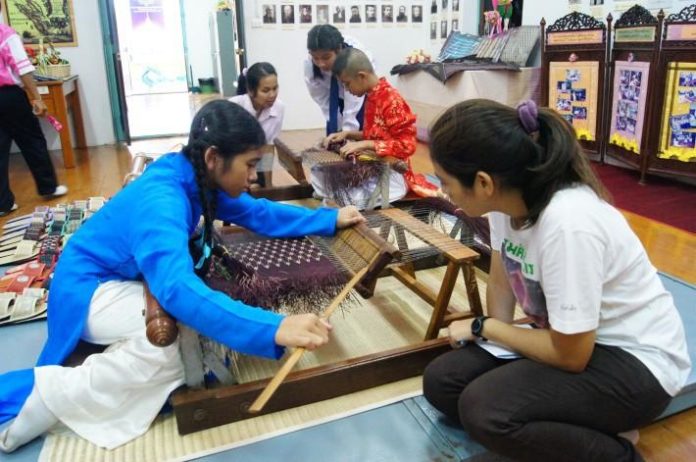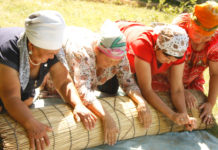Chanthaburi province has a plain geography, with part of it being rice fields. Sedge is one plant with excellent features for making mats, known as Chathabun mats. Chanthaburi people have practised mat weaving for over 120 years. The first group of people that began the weaving tradition was the Catholics living around the Catholic Church, a community known as the Vietnamese Village. In 1711, a priest came to look after the Catholic community there and brought in Vietnamese weavers. In his Chanthaburi travelogue, King Rama V wrote, “Only the Vietnamese make red sedge mats. Some weave as a square piece; others as a long banner.” At the time, sedge and kenaf were bought from different districts for weaving.
The kind of sedge used for mat weaving is kok klom (cyperus corymbosus rottb.), which has a glossy, sturdy culm (plant stem). When woven, the material offers soft and smooth touch. Sedges are bundled and dried and dyed. In the beginning, only natural dyes were used, extracted from barks or bulbs. Red is from rubber tree barks; black from ebony and mud; and yellow from turmeric.
Later, industrial colours are used, such as a German dye with charmeuse and silk, making the process of sedge dyeing easier. Weaving begins after the dyed sedges are dry. The Vietnamese residents have been very good at creating designs, such as rose, garuda (mythical bird) and other Thai motifs. One characteristic of Chanthabun mats is that they are black or red and use kenaf as the warp, which makes the mats more durable than those made of plastic warp. Forming of mat farmer weaving groups began in 1972, with members assigned to farming, weaving and stitching divisions. These mat weaving groups expanded between 1978 and 1981. Chanthabun mats can be found both in Bangkok and in the provinces and are also exported overseas.






